
The roles of telemetry and data acquisition are very often closely related and indeed use the same information from the plant. Remote control applications generally require the use of some form of telemetry, to get the signals from one location to another over some distance. This is generally a point-to-point system, however, modern telemetry systems are no longer confined just to the one to one applications with plants requiring more complex architectures for telemetry.
The telemetry system needs to use either existing plant cables/plant infrastructure or wireless means to transfer the signals. Omniflex's recently launched T2 Maxiflex CPUs are designed specifically for data acquisition and telemetry applications. They require no user application programs when used for data acquisition or telemetry applications, making them an ideal platform for telemetry systems.
One simply plugs them in; connects field wiring and powers up. All I/O is scanned automatically and I/O status assembled into data interchange table (DIT). Using a technique called 'Network Subscriptions' (same idea as subscribing to a magazine from the newsagent) the data required by either party can be shared between themselves. This is done on time interval basis for analogs and change of state for digitals. This is achieved without writing one line of program code. Maxiflex is configured using a Windows-based configuration management package which edits the Maxiflex DIT table and invokes the network services necessary to implement the data transfer between either end of the telemetry system. These configuration files can be saved and stored on the PC/laptop. Configuration can be done at the unit itself or via the network, which is especially useful when access to the other end of the system is difficult. These tools also facilitate browsing of the system for engineering staff.
Being modular and flexible, Maxiflex can accommodate systems of varying size, from those with primitive front end instruments right up to sophisticated measurement devices with on-board communications ports, eg, RS232/RS485, Modbus, HART, Ethernet.
Network media that is supported includes copper cable, radio - wireless, fibre optic and combinations of all the aforementioned.
Maxiflex networks can be implemented on copper cable (screened twisted pair - instrument cables) up to 10 km between the furthest points. Radio systems can be used for wireless applications where cable infrastructure is non-existent or cabling costs are prohibitive. Other network media such as fibre optic cable or Ethernet plant backbone, etc, can also be used. A Maxiflex telemetry system can also comprise combined elements of the above media.
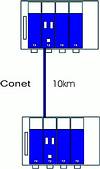
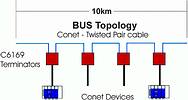
Telemetry topologies include point-to-point and multidrop bus (Figure 1, (a) and (b)) complex - star, ring, and combinations (Figure 2, (a) and (b)) and redundant link.
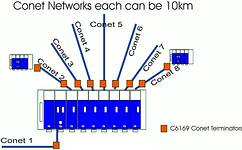
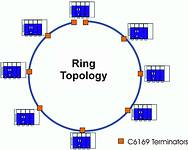
Maxiflex can be used to implement simple point-to-point or multidrop (cable sharing) systems right the way up to advanced and complex plant topologies mixing combinations of star, ring and bus and even redundant network connections where necessary. Supported communications protocols include Conet (twisted pair copper cables or existing plant cable), Conet/m (Conet for wireless applications radio links), Conet/e (Conet on Ethernet based infrastructure), modbus (RS232/RS485 based communications) and modbus TCP (Ethernet based infrastructure).
The configuration is easy, using a free Windows-based software package called 'OmniSet' and a serial cable available from Omniflex. Conet Explorer is a complete suite of software for configuration management, programming and terminal access which has full features to cater for the needs of the end users system. Simple selection of pull down options allows the user to completely configure the CPU. This configuration includes the ability to create multidrop telemetry systems using the Omniflex Conet local area network up to 10 km on twisted pair cable.

Maxiflex provides a cost-effective solution to telemetry applications and simplifies the field I/O systems by eliminating the need to write time-consuming application programs for telemetry. Should some control or interlocking be required this can be integrated within the system as an application program. An IEC61131 programmed CPU can also be used for application where the user may want to write control applications in ladder or function block. Maxiflex I/O systems cover analog inputs, voltage, current, thermocouple, RTD and digital inputs, potential free and voltages up to 200 V d.c. series contact chains, pulse inputs up to 50 kHz, Modbus devices, custom RS232 or RS485 protocols. Many field devices have HART protocol on board and this can be wired directly into the Maxiflex system via a HART network interface module. This has the benefit of making the entire spectrum of field instrument data available to the supervisory system.
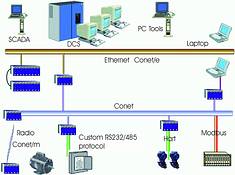
Integration into scada is easily achieved from PC systems and all network data can be made available through the use of Windows operating system OPC servers to which the scada systems become clients to retrieve the data.
For more information contact Ian Loudon, Omniflex, 031 207 7466, www.omniflex.com
| Tel: | +27 31 207 7466 |
| Email: | [email protected] |
| www: | www.omniflex.com |
| Articles: | More information and articles about Omniflex Remote Monitoring Specialists |

© Technews Publishing (Pty) Ltd | All Rights Reserved